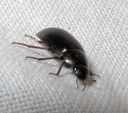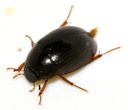Hydrobius
Hydrobius
Classification
- Phylum: Arthropoda
- Subphylum: Hexapoda
- Class: Insecta
- Order: Coleoptera
- Suborder: Polyphaga
- Superfamily: Hydrophiloidea
- Family: Hydrophilidae
- Subfamily: Hydrophilinae
- Tribe: Hydrobiusini
- Genus: Hydrobius
Pronunciation
How to pronounce Hydrobius: /hɪˈdroʊbiəs/
These audio files are automatically generated. While they are not always 100% accurate, they are a good starting point.
Images






Summary
Hydrobius is a genus of hydrophilid beetles characterized by their distribution across the Holarctic region. They play significant roles in aquatic ecosystems as decomposers.
Physical Characteristics
Small to medium-sized beetles, generally characterized by a glossy appearance and a somewhat flattened body shape, with long antennae and legs adapted for swimming.
Identification Tips
Look for characteristics such as dark coloration, a smooth surface, and a robust body shape typical of hydrophilids. Species can sometimes be distinguished by size and specific coloration patterns.
Habitat
Primarily found in freshwater habitats such as ponds, marshes, and slow-moving streams. They prefer environments with abundant vegetation and organic matter.
Distribution
Holarctic distribution; widespread in North America, most diverse in East Asia with total nine recognized species.
Diet
Aquatic detritivores, feeding on decaying organic matter and algae in their environment.
Life Cycle
Life cycle includes egg, larval, pupal, and adult stages. Larvae are aquatic and when mature, they pupate before emerging as adults.
Reproduction
Reproduces sexually, with females laying eggs in or near water bodies. The larvae develop in aquatic environments before metamorphosing into adults.
Predators
Potential predators include fish, amphibians, and larger aquatic invertebrates.
Ecosystem Role
Important decomposers in aquatic ecosystems, contributing to nutrient cycling through the breakdown of organic materials.
Collecting Methods
- Netting from aquatic environments
- Trap collection in stagnant water bodies
Preservation Methods
- Ethanol preservation
- Dried specimens mounted on pins
Similar Taxa
- Hydrophilus
- Aphydrus
- Laccobius
Misconceptions
Often confused with other aquatic beetles, especially those of the family Dytiscidae (diving beetles), though Hydrophilidae can be distinguished by their physiology and habitat preferences.
Tags
- Hydrophilidae
- Beetles
- Aquatic
- Freshwater
- Biodiversity